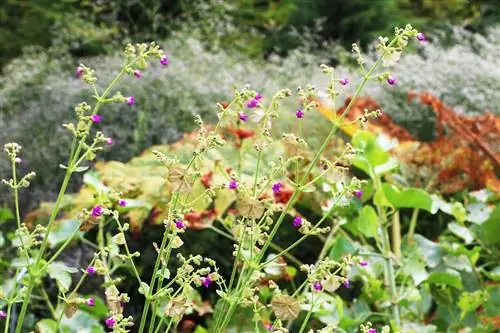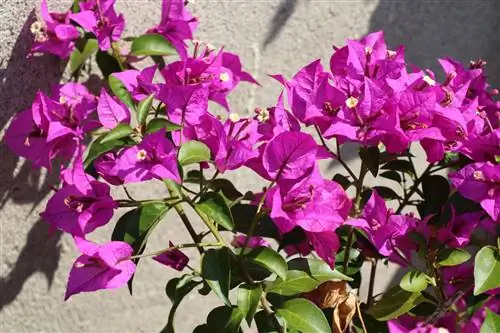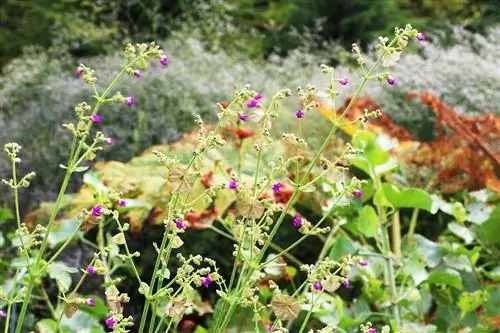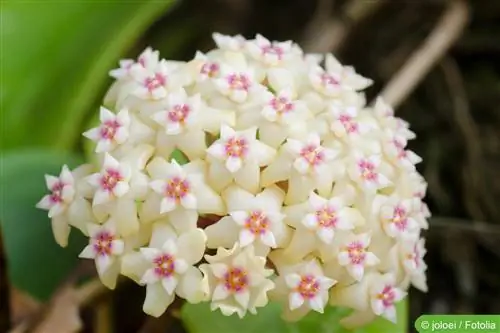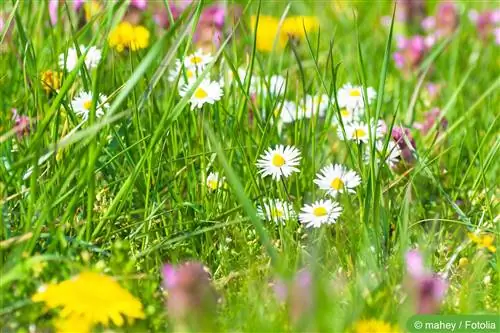- Author admin [email protected].
- Public 2023-12-17 03:39.
- Last modified 2025-01-24 12:45.
This attractive summer bloomer grows perennially and herbaceously with heights of up to 200 cm. Their fragrant and colorful flowers only open in the late afternoon. Hence the nickname 'four o'clock flower'.
Hardy or not?
Due to its natural origin, the Japanese miracle flower (Mirabilis jalapa) is a plant that loves warmth and sun. This has the disadvantage that it is not hardy in this country and therefore cannot overwinter outdoors. It is still possible to overwinter the beet-like tubers because this fragrant and flowering plant usually grows perennial. Optimal conditions during the winter are a prerequisite for it to sprout again in spring.
Preparing for winter storage
It only presents its colorful flowers in the evening hours and exudes a wonderful scent. Who wouldn't want to experience that every year? After flowering, shoots and leaves turn yellow. The plant moves in and stores reserve substances from the green parts of the plant above ground in its tubers for the next season. In order not to waste energy and to prevent both the formation and growth of seed heads, the withered flowers should first be cut off.
- Stop fertilizing completely from September
- Reduce watering quantities more and more
- Stop watering shortly before digging
- Soil can then be removed more easily from the tubers
- dig neither too early nor too late
- as soon as outside temperatures permanently fall below ten degrees
- Get mirabilis tubers out of the ground with a digging fork
- carefully remove adhering soil
- shorten retracted shoots to five centimeters
- Short roots, remove rotten parts
- If necessary, sprinkle wounds with charcoal ash
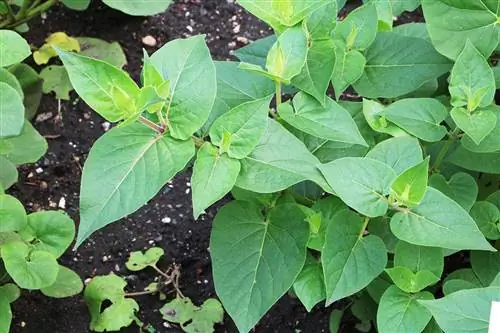
Since Mirabilis tubers root very quickly, they are usually so deeply rooted by autumn that the turnip-like tubers can no longer be easily removed from the ground. In order to make overwintering easier in the future, it is advisable to grow the plants in appropriately large pots and later plant them together with the pot in the ground. This makes them easier to dig up in the fall and the tubers themselves cannot be damaged in the process. Properly stored and cared for, the tubers of this exotic beauty can last for several years. Good preparation is even more important.
Tip:
The dug up tubers should under no circumstances be cleaned with water. The moisture could soon lead to rot.
Conditions in winter quarters
Once the tubers are dry and free of soil residue, they can move to their winter quarters. It should be as dark and cool as possible, with temperatures between five and ten degrees, and definitely frost-free. It is best to place them on a wooden shelf or a grid. It is important that the tubers are well ventilated all around and that they are not packed close together to avoid mold and rot. Alternatively, you can place them in a box wrapped in sand or sawdust.
Caring for tubers
During storage in winter, the beet-like tubers of this flowering and fragrant plant should be regularly checked for damage, rot and pest infestation and affected specimens should be disposed of immediately. If the air in the room in question is too dry, it is advisable to spray the tubers with soft water, preferably rainwater, from time to time, about every two to three weeks. Otherwise they would dry out very quickly. However, they should not be too wet, just covered in a fine mist. However, if the humidity is rather high, you should turn it regularly. More care is usually not required.
Wintering
At the end of winter, around February/March, check the tubers to see whether new growth has already appeared. Then they should be planted.
- preferably use plant containers with multiple bottom openings
- For example, plant baskets such as those used for pond plants
- A strong root system has formed by May
- Plant young plants now in their final location
- Above all, it has to be bright and warm
- Soil should be frost-free for planting
- place the tubers about two to three centimeters deep in the soil
- Administer a dose of fresh compost for the best start
Tip:
The strong tubers of Mirabilis jalapa can easily be separated after overwintering and used for propagation.
Wintering makes sense?
Is overwintering worth it if the seeds don't cost much and sowing is quick and easy? There is also no need to find suitable quarters for overwintering. However, overwintering has its advantages. On the one hand, the tubers grow over the years and on the other hand, many hobby gardeners have particularly eye-catching or beautiful specimens that are definitely worth overwintering.
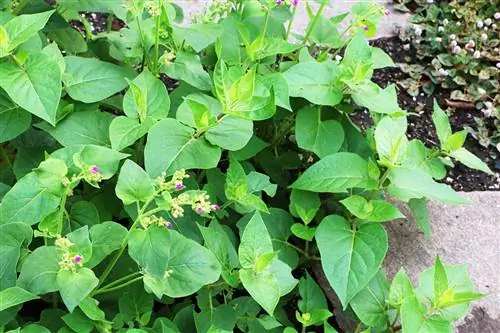
If it is still not possible because there is no suitable space available or the effort is too great, there is of course also the option of growing the plant again every year. You shouldn't remove all the wilted flowers. This way you can harvest the required number of seeds, which are usually produced in large numbers by the miracle flower. Sowing the pea-sized seeds is possible from March under glass on a warm and bright windowsill and in warmer regions from the end of April directly in the bed.
Caution poisonous
Particularly beautiful exotic plants often contain toxins, including the Mirabilis jalapa. Even if parts of the miracle flower are even used as a medicinal plant, that does not change its toxicity. Both the seeds and the tubers are poisonous and, if consumed, can cause symptoms of poisoning such as diarrhea, cramps and vomiting in both humans and pets. Dogs and cats in particular can easily get to the tubers, which are not particularly deep. In addition, consumption can cause hallucinations in humans and animals. Accordingly, you should keep your pets away from this plant.

